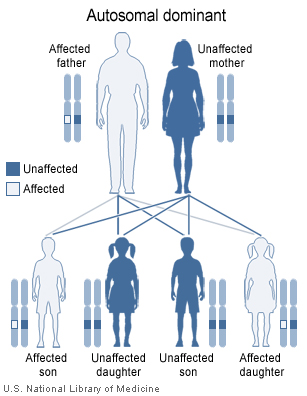
With respect to eye color, the allele for brown eyes (B) is dominant, and the allele for blue eyes (b) is recessive. If a person receives dominant alleles from both parents (BB) she will have brown eyes. Genetics is the science of heredity, genes, and the differences in living organisms. It is a biological discipline that deals with the structure and function of genes, their behavior and patterns of inheritance from the parents to the offspring.
Dominant and recessive are the two styles of genes. The foremost between dominant and recessive is, dominant gene is expresses totally inside the phenotype whereas recessive gene should not be totally expresses inside the phenotype. A dominant allele produces a dominant phenotype in individuals who have one copy of the allele, which can come from just one parent. For a recessive allele to produce a recessive phenotype, the individual must have two copies, one from each parent.
An individual with one dominant and one recessive allele for a gene will have the dominant. I Was So Poor I Wore A Potato Sack Dress To School. Now All The World Knows Me - Duration: 6:51.

ACTUALLY HAPPENED 474views. While it is often convenient to talk about a recessive allele or a dominant trait, dominance is not inherent to either an allele or its phenotype. Dominance is a relationship between two alleles of a gene and their associated phenotypes.
A dominant allele is dominant to a particular allele of the same gene that can be inferred from the. A recessive gene is a gene whose effects are masked in the presence of a dominant gene. Recessive Gene Definition. Every organism that has DNA packed into chromosomes has two alleles, or forms of a gene , for each gene : one inherited from their mother, and one inherited from their father. Since human cells carry two copies of each chromosome they have two versions of each gene.
These different versions of a gene are called alleles. Alleles can be either dominant or recessive. For example, the allele for. A person possessing one dominant allele and one recessive allele for a gene is said to be heterozygous for that trait because the alleles are different.
However, if a person possesses two alleles that are the same, such as two dominant alleles or two recessive alleles, then that person is homozygous for that trait. In our example here, brown is dominant over blue so you end up with brown eyes. A dominant gene is always expressed if present, and the recessive gene is only expressed with the homozygous recessive genotype. The way people write out dominant and recessive traits is the dominant one gets a capital letter and the recessive one a lower case letter. So for eye color, brown is B and blue is b. As I said above, people have two versions of each gene so you can be BB, Bb, or bb.
If a recessive allele is inherited together with a dominant allele, only the dominant phenotype will manifest. This means that almost every cell contains two copies of each gene , one from each parent. If an individual has either dominant alleles (or both recessive alleles) for the same gene , he is known as homozygous dominant or homozygous recessive.
If he has one dominant and one recessive allele of the gene , he is called as heterozygous. Let us understand this with an example. If one dominant allele and one recessive allele are present, the dominant allele trait will be expressed.
A recessive allele does not become a trait unless both copies of the gene , one from mom and one from da are present. If so, does the dominant gene stop the recessive gene from making anything? Or, does the recessive gene make a broken protein? If the recessive gene makes something, shouldn’t it be incompletely dominant or co- dominant ?
No comments:
Post a Comment
Note: Only a member of this blog may post a comment.